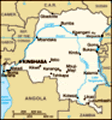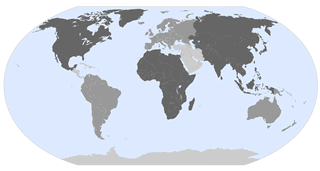Advertisement
Published: April 22nd 2012
My legs were more than a little wobbly after the five plus hour climb, one that took me up an increasingly steep gradient, made all the more difficult by alternating stretches of slippery smooth rock and loose, jagged gravel. But now I was nearly at the top, just a few feet away from my goal.
Before I mustered the energy to climb the last stretch, I turned to look at the surrounding vista. From my perch, more than 11,000 feet above sea level, I had an unhindered view of Lake Kivu, with the rambling outlines of distant Goma spread along its shore, and the wide, surprisingly flat plain at the base of the mountain, which quickly gave rise to another chain of mountains that mark the beginning of Rwanda. All looked verdantly healthy; all appeared peaceful.
Then I caught a whiff of a familiar, eggy smell, which pulled me back to the task at hand. Gingerly I made my way up the craggy surface to the edge; peering over, I caught my breath. There it was:
The lava lake.
***
There are few places on this amazing planet where one can come face to “face” with
a bubbling, churning cauldron of real lava. Actually, there are only five: Erta Ale in Ethiopia, Kilauea in Hawaii, Mount Erebus in Antarctica, Villarrica in Chile – and Mount Nyiragongo in the Democratic Republic of the Congo. Of these five, Nyiragongo possesses the largest and perhaps the most “violent” lakes, as it is fueled by a constant influx of lava. It also happens to be one of the more active volcanoes in Africa, having most recently erupted in 2002 (destroying a good portion of Goma in the process).
Why would I seek to climb an active volcano? Especially one resting in one of the most unstable countries in Africa (and indeed the world)?*
Back in November, when I was traveling in southern Uganda to go gorilla trekking, I had the rare opportunity to witness a full on eruption of Mount Nyamulagira, just across the nearby border with the DRC. From a safe distance, I watched lava shoot a thousand feet into the night air and a river of molten rock flow down its slope. And I itched to get closer. Call me crazy.
But I figured getting into the DRC, with all its political chaos and continuing
conflict, would not be possible in the near future. I filed away the idea of a visit to the Virunga chain of volcanoes as a dream to be fulfilled later on. However, as I began to plan my spring break in Burundi and Rwanda, I came across some interesting information.
The border between the sister towns of Gisenyi, Rwanda, and Goma, DRC, was apparently relatively easy to cross; plus this part of eastern Congo was fairly stable, allowing for access to the Congolese portion of Virunga National Park – and, most importantly, Nyamulagira’s sister volcano, Nyiragongo. I began to scheme how to fulfill my volcanological dreams.
There was a catch, though. The DRC had upped the visa fee to more than $280 - with the permit to visit the volcano costing an additional $200 (not including the costs of guides, rangers, etc.). I wasn’t sure I was going to be able to afford such, especially for what would amount to an overnight trip. But I discovered that there was something of a loophole in the visa situation – if you applied in advance and in conjunction with one of the permits to the park (for the gorillas or
the volcano), it was possible to get a special visa for $50 dollars (technically valid only for visiting in the near vicinity of Goma and the park). Now we were talking!
***
As I stepped up to the immigration window, Innocent, my guide, hovered behind me, keeping up a gentle banter in French with the Congolese official examining my passport and the printout of my tourist visa. They seemed on friendly terms, which I hoped was a good sign. I had been told that sometimes the border officers tried to claim that they didn’t recognize the special visa and would try to get visitors to fork out the full visa price. But I had no hassle; we were in the DRC within minutes of stamping out of Rwanda and stamping into country number three of my spring break trip.
This was the second land border crossing I was making in a week. I have always found borders fascinating places, these artificial demarcations separating countries. Sometimes they are simple affairs; within the EU, for example, you might not even know you’ve crossed one (oops, am I in Germany now?). But sometimes they are trickier, even fortified affairs (I
don’t think I’ll be heading into North Korea anytime soon). Of the crossings I’ve made in my travels, though, I think the one between Rwanda and the DRC must rank among the most dramatic – not for the actual procedure, but for the remarkably stark contrast between one side and the other.
In Gisenyi, all is well maintained, clean, orderly. It’s a town in a country that is clearly prosperous and stable. On the up. But step into Goma, and you know you are in a deeply troubled place, even in a conflict zone.** The roads deteriorate rapidly, buildings are in serious disrepair, trash blows along the ground. A number of UN compounds line the road leading out of town, housing peacekeeping troops from around the world. It all had a wild-west feel (except we were in the Congo’s wild east…). What a difference a border makes.
***
The Congo had loomed large, both figuratively and literally, in my imagination even before I moved to Africa. Although perhaps first entering my consciousness when reading Joseph Conrad’s Heart of Darkness in high school, the Congo began making an even greater impression on me the more I
taught world history and had to address the topic of colonialism in Africa. I was fascinated by the dark tale of how King Leopold II of Belgium - that tiny country on the edge of Europe - came to control as his personal fiefdom the vast heart of Africa – calling his claim, with terrifying irony, the Congo Free State. The reports of unspeakable horrors that began to leak out of the Congo during the late nineteenth/early twentieth centuries – the stories of native hands being cut off, of cruel tortures of women and children, of the countless deaths of innocent Congolese, all for the profit of a few European men – set off one of the first major international human rights campaigns in history. This, in turn, led to Belgium taking control of the “Free State” as a more traditional colony in 1908, but the Congo’s troubles were far from over.
Although often heralded by the Belgians as the “model” colony, with its new roads and hospitals and schools, the Congo continued to suffer gross indignities under colonial rule. Few if any Congolese were allowed into positions of authority, with only a handful able to gain a university
level education.*** So when independence did come in 1960 – hastily and patronizingly granted by Belgium – the new republic found itself on extremely shaky ground. Patrice Lumumba, the first democratically elected prime minister, was dead just over six months after taking office, victim of a political situation that began to unravel almost immediately after independence – with break away states and Cold War powers vying for influence with the various factions‡.
The unfolding political story of the Congo post-independence has been one of the most disheartening of any in Africa. After Lumumba, Joseph Mobutu (later Mobuto Sese Seko) eventually came to power and ended up ruling the country (which he renamed Zaire) much like Leopold II had, plundering it for his own benefit and causing a complete breakdown in services and infrastructure, until he was ousted in 1997. Unfortunately, his successors – Laurent-Desire Kabila (1997-2001) and Joseph Kabila (2001-present) – have proven little better in bringing peace and stability to the Congo (now the Democratic Republic of the Congo). They even entangled their country in the conflicts unfolding in Burundi and Rwanda. Actually, Kabila, the father, overthrew Mobutu with forces largely drawn from the Tutsi community based on
the Congolese side of Lake Kivu.
The DRC remains highly fractured, riven by the competing ethnic and political claims of countless government and anti-government factions. Hopes for future stability look grim, especially since the conflicts are fueled by neighboring governments and multinational companies who all want to plunder the rich resources of the Congo for their own profit.
I never imagined, considering all this turmoil, that I would have the opportunity to get an internal glimpse of the DRC – and from the top of a volcano no less!
***
My toes were crying foul by the time we finally reached the ranger station after four hours of steep descent on loose volcanic rock. But I wouldn’t have changed a thing; trekking to the top of Nyiragongo, camping on its rim, and witnessing the humbling drama of its lava lake was a once in a lifetime event I will not soon forget.
Neither will I forget the cheerful perseverance of the Congolese I encountered in my brief stay in the DRC. As one of the guides explained: “When there is fighting, when there is trouble, we Congolese just sing and dance! What else are we
to do?”
I hope for their sake that someday they will be able to sing and dance without the threat of violence hanging over their heads…
*The Democratic Republic of the Congo came in number 4 on the 2011 Failed States Index – but Sudan was number 3, so who am I to judge?
** Innocent, just to be fully open about what I was undertaking, informed me that a week before I arrived that Virunga National Park had been closed due to fighting between the Congolese army and rebel forces.
***On the eve of independence, there were no Congolese military officers, only three Congolese managers in the colonial civil service, and a total of about 30 Congolese university graduates – yet the Congo was the one of the largest colonies in Africa (now that Sudan has divided, it is the second largest country in Africa).
‡ Lumumba’s assassination was supported, if not conducted by, the CIA due to his turning to the Soviets for help during the crisis.
Advertisement
Tot: 0.131s; Tpl: 0.032s; cc: 15; qc: 30; dbt: 0.0601s; 1; m:domysql w:travelblog (10.17.0.13); sld: 1;
; mem: 1.2mb






















